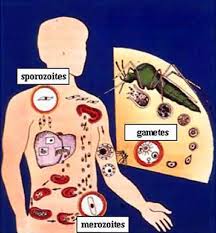 Acquired immune deficiency syndrome or acquired immunodeficiency syndrome (AIDS) is a disease of the human immune system caused by the human immunodeficiency virus (HIV).
Acquired immune deficiency syndrome or acquired immunodeficiency syndrome (AIDS) is a disease of the human immune system caused by the human immunodeficiency virus (HIV).This condition progressively reduces the effectiveness of the immune system and leaves individuals susceptible to opportunistic infections and tumors. HIV is transmitted through direct contact of a mucous membrane or the bloodstream with a bodily fluid containing HIV, such as blood, semen, vaginal fluid, preseminal fluid, and breast milk.
This transmission can involve anal, vaginal or oral sex, blood transfusion, contaminated hypodermic needles, exchange between mother and baby during pregnancy, childbirth, breastfeeding or other exposure to one of the above bodily fluids.
AIDS is now a pandemic. In 2007, it was estimated that 33.2 million people lived with the disease worldwide, and that AIDS killed an estimated 2.1 million people, including 330,000 children. Over three-quarters of these deaths occurred in sub-Saharan Africa, retarding economic growth and destroying human capital.
Genetic research indicates that HIV originated in west-central Africa during the late nineteenth or early twentieth century. AIDS was first recognized by the U.S. Centers for Disease Control and Prevention in 1981 and its cause, HIV, identified in the early 1980s.
Although treatments for AIDS and HIV can slow the course of the disease, there is currently no vaccine or cure. Antiretroviral treatment reduces both the mortality and the morbidity of HIV infection, but these drugs are expensive and routine access to antiretroviral medication is not available in all countries. Due to the difficulty in treating HIV infection, preventing infection is a key aim in controlling the AIDS pandemic, with health organizations promoting safe sex and needle-exchange programmes in attempts to slow the spread of the virus.
AIDS is a mix of infections and complications as a result of progressive damage to the body’s immune system caused by HIV. AIDS is now considered a pandemic.
 Influenza, commonly referred to as the flu, is an infectious disease caused by RNA viruses of the family Orthomyxoviridae (the influenza viruses), that affects birds and mammals. The name influenza is Italian and means "influence" (Latin: influentia). The most common symptoms of the disease are chills, fever, sore throat, muscle pains, severe headache, coughing, weakness and general discomfort. Sore throat, fever and coughs are the most frequent symptoms. In more serious cases, influenza causes pneumonia, which can be fatal, particularly for the young and the elderly. Although it is often confused with other influenza-like illnesses, especially the common cold, influenza is a much more severe disease than the common cold and is caused by a different type of virus. Influenza may produce nausea and vomiting, particularly in children, but these symptoms are more common in the unrelated gastroenteritis, which is sometimes called "stomach flu" or "24-hour flu".
Influenza, commonly referred to as the flu, is an infectious disease caused by RNA viruses of the family Orthomyxoviridae (the influenza viruses), that affects birds and mammals. The name influenza is Italian and means "influence" (Latin: influentia). The most common symptoms of the disease are chills, fever, sore throat, muscle pains, severe headache, coughing, weakness and general discomfort. Sore throat, fever and coughs are the most frequent symptoms. In more serious cases, influenza causes pneumonia, which can be fatal, particularly for the young and the elderly. Although it is often confused with other influenza-like illnesses, especially the common cold, influenza is a much more severe disease than the common cold and is caused by a different type of virus. Influenza may produce nausea and vomiting, particularly in children, but these symptoms are more common in the unrelated gastroenteritis, which is sometimes called "stomach flu" or "24-hour flu". The 1918 flu pandemic (commonly referred to as the Spanish Flu) was an influenza pandemic that spread to nearly every part of the world. It was caused by an unusually virulent and deadly influenza A virus strain of subtype H1N1. Historical and epidemiological data are inadequate to identify the geographic origin of the virus. Most of its victims were healthy young adults, in contrast to most influenza outbreaks which predominantly affect juvenile, elderly, or otherwise weakened patients. The flu pandemic has also been implicated in the sudden outbreak of encephalitis lethargica in the 1920s.
The 1918 flu pandemic (commonly referred to as the Spanish Flu) was an influenza pandemic that spread to nearly every part of the world. It was caused by an unusually virulent and deadly influenza A virus strain of subtype H1N1. Historical and epidemiological data are inadequate to identify the geographic origin of the virus. Most of its victims were healthy young adults, in contrast to most influenza outbreaks which predominantly affect juvenile, elderly, or otherwise weakened patients. The flu pandemic has also been implicated in the sudden outbreak of encephalitis lethargica in the 1920s. Bubonic plague is the best known manifestation of the bacterial disease plague, caused by the Gram-negative bacterium Yersinia pestis (formerly known as Pasteurella pestis). It belongs to the family Enterobacteriaceae. The term "bubonic plague" was often used synonymously for plague, but it does in fact refer specifically to an infection that enters through the skin and travels through the lymphatics, as is often seen in flea-borne infections. Bubonic plague kills about half of infected patients in 3–7 days without treatment, and may be the Black Death that swept through Europe in the 1340s, killing tens of millions.
Bubonic plague is the best known manifestation of the bacterial disease plague, caused by the Gram-negative bacterium Yersinia pestis (formerly known as Pasteurella pestis). It belongs to the family Enterobacteriaceae. The term "bubonic plague" was often used synonymously for plague, but it does in fact refer specifically to an infection that enters through the skin and travels through the lymphatics, as is often seen in flea-borne infections. Bubonic plague kills about half of infected patients in 3–7 days without treatment, and may be the Black Death that swept through Europe in the 1340s, killing tens of millions. Malaria is a vector-borne infectious disease caused by a eukaryotic protist of the genus Plasmodium. It is widespread in tropical and subtropical regions, including parts of the Americas, Asia, and Africa. Each year, there are approximately 350–500 million cases of malaria, killing between one and three million people, the majority of whom are young children in Sub-Saharan Africa. Ninety percent of malaria-related deaths occur in Sub-Saharan Africa. Malaria is commonly associated with poverty, but is also a cause of poverty and a major hindrance to economic development.
Malaria is a vector-borne infectious disease caused by a eukaryotic protist of the genus Plasmodium. It is widespread in tropical and subtropical regions, including parts of the Americas, Asia, and Africa. Each year, there are approximately 350–500 million cases of malaria, killing between one and three million people, the majority of whom are young children in Sub-Saharan Africa. Ninety percent of malaria-related deaths occur in Sub-Saharan Africa. Malaria is commonly associated with poverty, but is also a cause of poverty and a major hindrance to economic development. Ebola virus: A notoriously deadly virus that causes fearsome symptoms, the most prominent being high fever and massive internal bleeding. Ebola virus kills as many as 90% of the people it infects. It is one of the viruses that is capable of causing hemorrhagic (bloody) fever.
Ebola virus: A notoriously deadly virus that causes fearsome symptoms, the most prominent being high fever and massive internal bleeding. Ebola virus kills as many as 90% of the people it infects. It is one of the viruses that is capable of causing hemorrhagic (bloody) fever. Cholera is a bacterial disease usually spread through contaminated water. Cholera causes severe diarrhea and dehydration. Left untreated, cholera can be fatal in a matter of hours.
Cholera is a bacterial disease usually spread through contaminated water. Cholera causes severe diarrhea and dehydration. Left untreated, cholera can be fatal in a matter of hours. Smallpox is a contagious, disfiguring and often deadly disease caused by the variola virus. Smallpox is believed to have been around for thousands of years. Few other illnesses have had such a devastating effect on human health and history.
Smallpox is a contagious, disfiguring and often deadly disease caused by the variola virus. Smallpox is believed to have been around for thousands of years. Few other illnesses have had such a devastating effect on human health and history.
